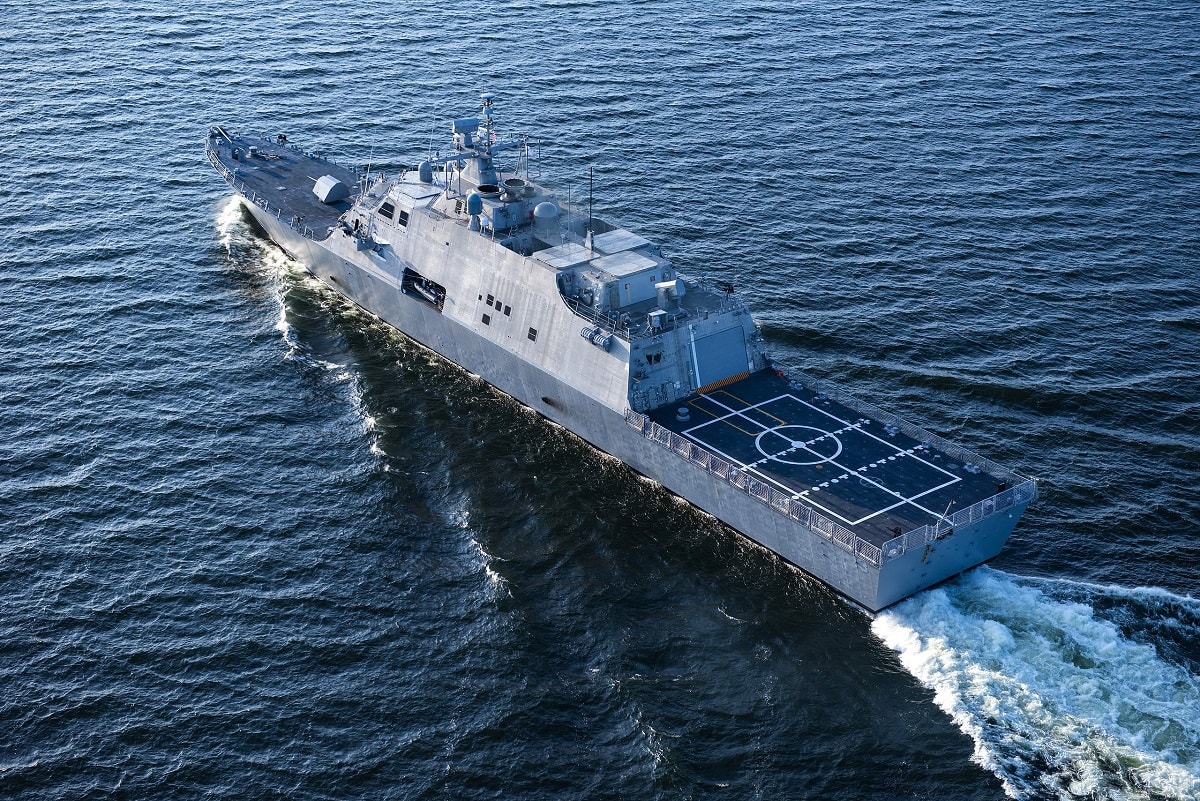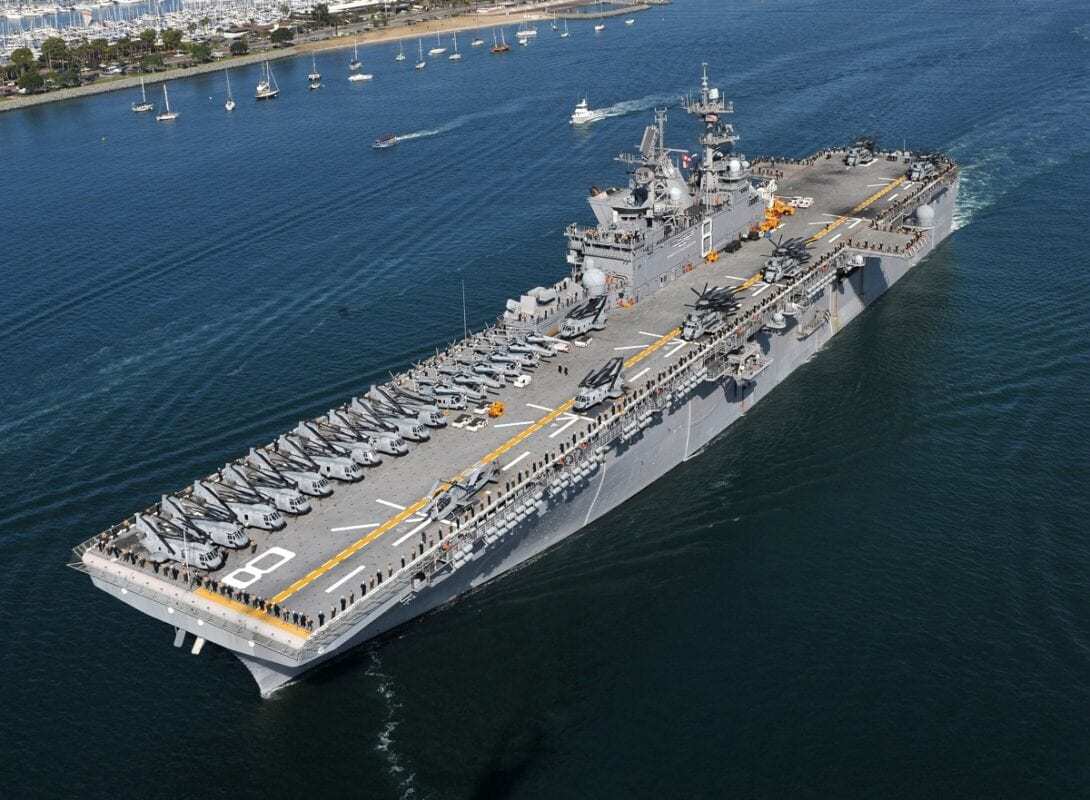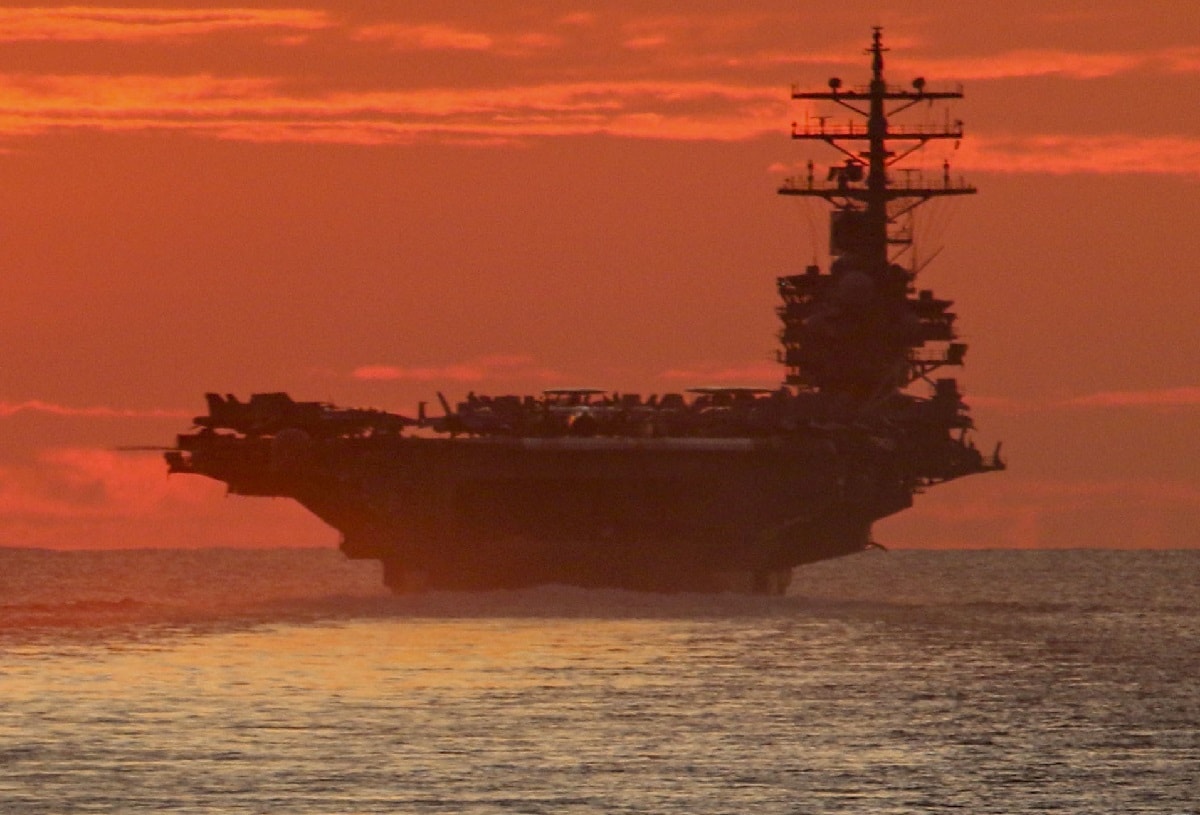The U.S. Navy, Marine Corps, and Coast Guard—the U.S. sea services—are currently prosecuting “Large Scale Exercise 2021.” The maneuver’s banal codename belies its ambition. Navy spokesmen bill it as the biggest exercise in a generation, and one that spans seventeen time zones. Its immediate goal is to prove out operational concepts that have remained mostly hypothetical—concepts bearing such arcane-sounding titles as Distributed Maritime Operations, Littoral Operations in a Contested Environment, and Expeditionary Advanced Base Operations.
Its ulterior goal is to make a statement about American power, namely that the sea services can manage multiple challenges posed by the likes of Russia, China, and Iran. The services will try to make believers out of potential foes the United States wants to deter, as well as allies and friends it wants to hearten to stand against these predators.
The basic idea animating the newfangled operating concepts is that the sea services need to spread out and conscript geography to deny a hostile fleet control of the sea and ultimately win control for America and its allies. Concentrating too much of the U.S. fleet’s combat power in a few large ships means that hostile action can nullify a major percentage of the fleet’s fighting prowess by knocking out a single aircraft carrier, cruiser, or destroyer. But by dispersing combat power among swarms of lighter, cheaper warships and warplanes, along with small missile-armed units perched on Pacific islands, sea-service chieftains can field a more resilient force—a force that can battle on to victory despite losing one or a few vessels.
That’s the idea, anyway.
Subjecting these concepts to the stern test of reality is imperative. Distributed operations depend on effective communications and coordination among units that are widely separated from one another in space. That means connecting them using networks that harness the electromagnetic spectrum. But command-and-control networks are a key potential frailty in these concepts as much as they’re an asset. For example, China’s People’s Liberation Army (PLA) has devised a concept known as “systems-destruction warfare” that envisions targeting whatever bonds a distributed enemy force together.
Networks in particular.
If the PLA can disrupt U.S. networks, it will have split the U.S. force into isolated clots of combat power it can overwhelm one by one. In effect the idea is to put China’s foes in a damned-if-you-do, damned-if-you-don’t situation. If U.S. forces mass in space for action, reducing their reliance on the electromagnetic spectrum, they expose themselves to concentrated PLA air or missile attacks. If they disperse in space to avoid the brunt of PLA action, systems-destruction warfare aims to cut the connective tissue that makes a U.S. fleet a cohesive fighting force. Putting adversaries in a hopeless position is a time-tested way to prevail in armed conflict. The victor might not even have to fight if it appears invincible in peacetime.
Suffice it to say that figuring out how to blunt and overcome China’s way of war is a matter of extreme urgency for the Pentagon.
For the latest wisdom on wargames in general and Large Scale Exercise 2021 in particular, why not look back a century or two? Prussian soldier-theorist Carl von Clausewitz pronounces a tepid verdict on peacetime maneuvers, calling them “a feeble substitute for the real thing.” Yet he hastens to add that “they can give an army an advantage over others whose training is confined to routine, mechanical drill.” How well—and how realistically—competitors train in peacetime biases their prospects toward success or failure in wartime.
Therein lies the rub. It’s hard to simulate the climate of war—a climate pervaded by chance, danger, and stark passions such as rage, fear, and spite—when participants know they’re operating in a controlled environment where no enemy will rain down fire on their heads. In other words, exercises have a canned quality that’s largely unavoidable. Still, says Clausewitz, it is possible to design them to “train officers’ judgment, common sense, and resolution” so that real-world battle will not “amaze and confuse” them. They will have some acquaintanceship with the climate of war. And some is better than none.
Rear Admiral Bradley Fiske took a less lukewarm view of wargames than did Clausewitz. A Spanish-American War veteran, Fiske was a U.S. Navy engineering prodigy. In 1942 the New Yorker described him as “one of the notable naval inventors of all time,” having “found time to invent a hundred and thirty-odd improvements to naval equipment” while still shouldering the duties expected of naval officers of his day.
Admiral Fiske discerned two chief determinants of wargames’ efficacy. One, a culture founded on the scientific method fosters the free play of ideas. Argument clashes with counterargument until a synthesis of ideas points the way ahead. He was much taken with the imperial German approach to naval development. The scientific habit of mind was baked into German Navy culture. In his best-known work, The Navy as a Fighting Machine (1916), Fiske hailed German leaders for using Kriegspiele—elaborate and frequent wargames—to design an imperial fleet fit for the times and the major opponent, Great Britain’s Royal Navy.
German fleet designers played “numberless war games” according to Fiske. From these experiments on the game floor, mariners and their political overseers determined “the naval strategy best adapted to Germany’s needs—not only in matters of general principle, not only as to tactics, training, education, cooperation with the army, and the size of fleet required to carry out the policy of the nation—but also as to the composition of the fleet, relative proportions of vessels of the various types, and the characteristics of each type.” Games were enormously beneficial.
But science is a culture of doubt. The science is never settled in politics or warfare, fields of endeavor where dynamism is the watchword. Navies should never accept the results of wargames without question or consider the results permanent—even if verified in real-world trials. For German leaders it was crucial to put ideas to the test before embracing them. That meant reducing ideas generated through gaming to engineering and subjecting ships and weaponry to field trials. As Fiske observes, “experimental work, no matter how promising or alluring, must be recognized as of unproved and doubtful value; and no scheme, plan, or doctrine must be incorporated in the naval machine, or allowed to pose as otherwise than experimental, until successful trials shall have put it beyond the experimental stage.”
A scientific cast of mind behooves the U.S. Navy, Marine Corps, and Coast Guard as they flex new concepts and technologies today—just as it profited the German Navy in Kriegspiele a century ago.
And two, culture is a product of leadership. Top leadership that refrains from imposing its views on subordinates—and fettering their autonomy of thought—is crucial to an inquisitive culture. German naval overseers set the tone for the service by remaining humble and self-restrained. They not just tolerated but stoked free-range debate among inventive subordinates. They refused to tolerate slipshod game design, but they also refused to use their authority to bias Kriegspiele toward outcomes they preferred on personal or institutional grounds. “Nothing was left to chance; nothing was decided by guessing; no one man’s dictum was accepted,” reports Fiske.
Enlightened senior leadership is central to fruitful gaming. That’s an insight as compelling in 2021 as in 1916.
It’s also possible to detect a warning in Fiske’s writings. A navy that astutely combines leadership with culture can stage a leap from backwardness to the forefront of marine affairs. Culture is a stubborn thing. A newcomer to naval warfare—imperial Germany or Japan in Fiske’s day, or Communist China today—can surpass established powers because it isn’t bound by a seafaring culture of long standing. It can start afresh, fitting itself to the times and circumstances, where an established power must struggle against ingrained customs and practices that hamper efforts to keep pace with the times. Maintains Fiske, “a young and vigorous individual or organization, endowed with proper energy and mentality, can appropriate whatever is valuable for its purposes from its elders, and reject whatever those elders have had fastened on them by circumstances or tradition, and develop a superior existence.”
Beware, America.
Fiske seemed to believe wargames’ chief benefits were economy and speed. They were affordable and quick whereas constructing an experimental fleet would be not just forbiddingly expensive but slow. “The province of the game-board is merely to try out on a very small scale, under proper conventions or agreements, things that could not be tried out otherwise, except at great expense, and very slowly; to afford a medium, halfway between actual trials with big ships and mere unaided reasoning, for arriving at correct conclusions.” Experimentation would lumber along at frightful expense if it meant building squadrons of ships to vet concepts.

180711-N-N0101-368.LAKE MICHIGAN (July 11, 2018) The future littoral combat ship USS Wichita (LCS 13) conducts acceptance trials, which are the last significant milestone before a ship is delivered to the Navy. LCS-13 is a fast, agile, focused-mission platform designed for operation in near-shore environments as well as the open-ocean. It is designed to defeat asymmetric threats such as mines, quiet diesel submarines and fast surface craft. (U.S. Navy photo courtesy of Lockheed Martin/Released)
Games are cheap by contrast.
They’re also iterative. Says Fiske, “the partial advantage of the game-board over the occurrences of actual war, for the purpose of studying strategy, lies largely in its ability to permit a number of trials very quickly; the trials starting either with identical situations, or with certain changes in conditions.” Learning progresses swiftly when one round of gaming cascades into the next into the next.
Large Scale Exercise 2021 is a crucible for ratifying—or amending, or discarding—new ideas and hardware. Let’s hope the sea services made good use of cheap, speedy, iterative wargames before submitting Distributed Maritime Operations, Littoral Operations in a Contested Environment, and Expeditionary Advanced Base Operations to high-seas trials. And let’s hope they manage to replicate the climate of war. Whether they can is open to question. Clausewitz and Fiske might blanch at the exercise’s hybrid, or “synthetic” nature. Many of the players are present at scenes of simulated combat; many are not. For example, the cruiser USS San Jacinto is taking part in “North Atlantic” operations while moored in Norfolk, Virginia. An overlay of artificiality is possible if not probable.

111114-N-KD852-268 SAN DIEGO (Nov. 14, 2011) Sailors and Marines man the rails aboard the amphibious assault ship USS Makin Island (LHD 8) as the ship departs San Diego on a regularly scheduled deployment in support of the Navy’s Maritime Strategy. This will be the maiden deployment for Makin Island, the Navy’s newest amphibious assault ship and the only U.S. Navy ship with a hybrid electric propulsion system. By using this unique propulsion system, the Navy expects to see fuel savings of more than $250 million during the ship’s lifecycle, proving the Navy’s commitment to energy awareness and conservation. (U.S. Navy photo by Chief Mass Communication Specialist John Lill/Released)
So once the maneuver reaches its end next week, naval leaders should critique their approach to designing and conducting it as penetratingly as they critique the sea services’ operational performance in it.
Ruthless self-criticism is a must—just as it was in imperial Germany, and for a long-dead American admiral. War will be even more unsparing.
James Holmes is J. C. Wylie Chair of Maritime Strategy at the Naval War College and a Nonresident Fellow at the Brute Krulak Center for Innovation & Future Warfare, U.S. Marine Corps University. The views voiced here are his alone.

